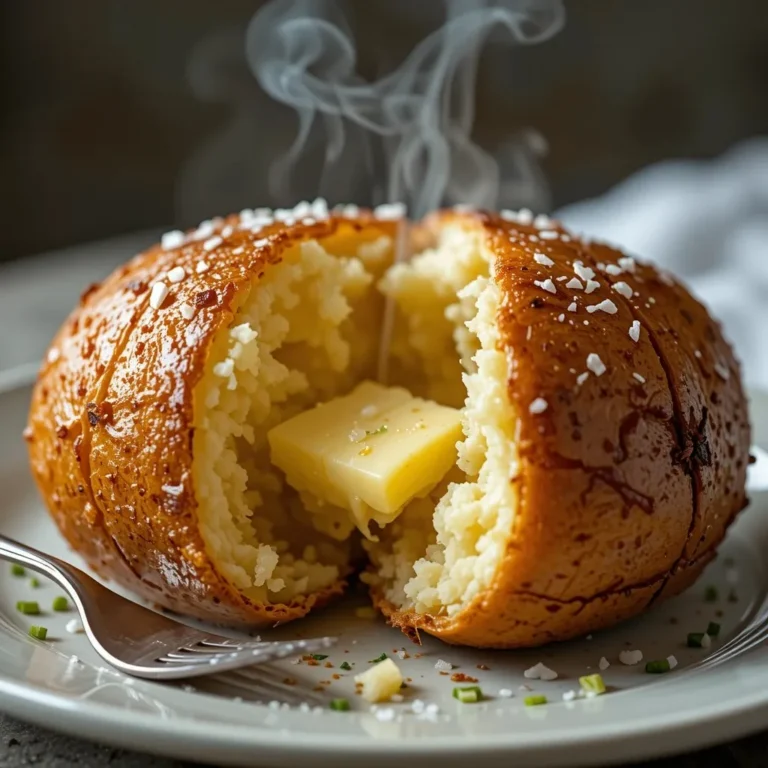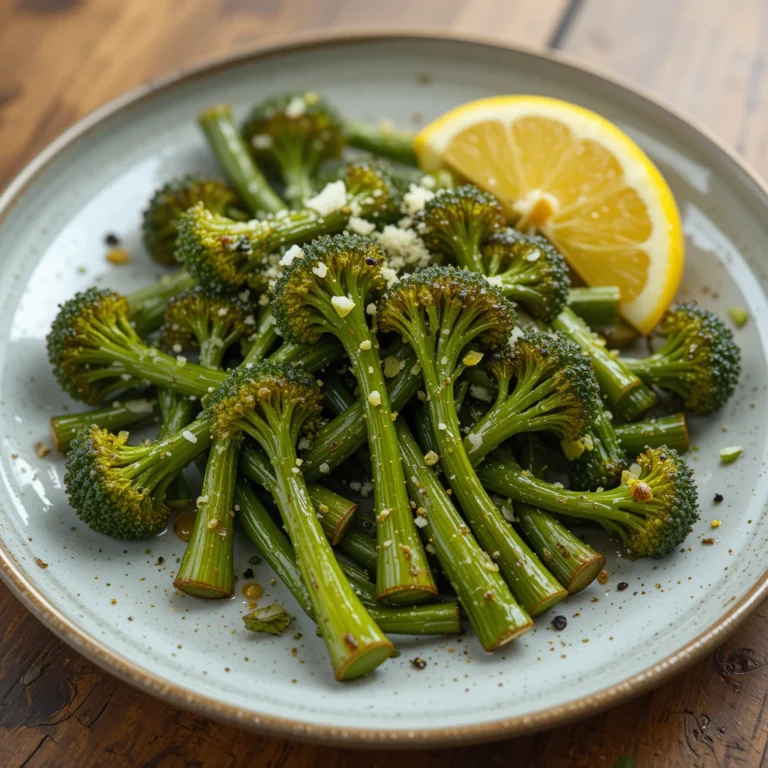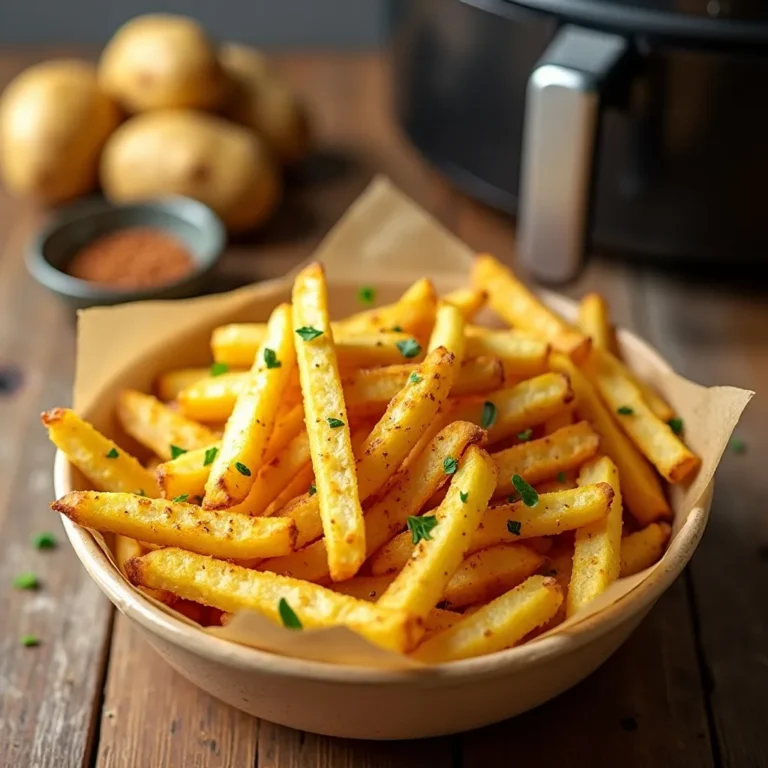Easy Air Fryer Japanese Eggplant in 15 Minute No Deep Frying
There’s something magical about watching Japanese eggplant transform in an air fryer. The silky flesh becomes tender and creamy while the outside gets beautifully caramelized. I discovered this method last summer when my garden was bursting with eggplants, and honestly,
I haven’t looked back since. This air fryer Japanese eggplant recipe takes just 15 minutes and requires minimal oil, making it healthier than traditional frying methods. If you loved my crispy air fryer zucchini, you’re going to be absolutely obsessed with this one!
What is Air Fryer Japanese Eggplant?
Ever wonder why this slender, purple beauty gets its own special name? Japanese eggplant is like the elegant cousin of the round globe eggplant—longer, thinner, and with fewer seeds.
When you cook it in an air fryer, you’re essentially giving it a spa treatment with hot circulating air that crisps the outside while keeping the inside luxuriously creamy. You know what they say: the way to anyone’s heart is through their stomach, and this dish definitely proves it! Trust me, once you try this method, you’ll want to make it every week.
Why You’ll Love This Air Fryer Japanese Eggplant
The Perfect Texture Every Single Time
Let me tell you what makes this recipe absolutely irresistible. The air fryer creates the most incredible contrast—a golden, slightly crispy exterior that gives way to melt-in-your-mouth tender flesh. No more oil-soaked, soggy eggplant! The high heat caramelizes the natural sugars, bringing out a subtle sweetness you never knew existed.
Budget-Friendly Home Cooking
Making air fryer Japanese eggplant at home costs a fraction of what you’d pay at a restaurant. A couple of eggplants, some basic seasonings, and you’ve got an impressive side dish or main course that looks and tastes gourmet. Plus, you’re using minimal oil—we’re talking just a tablespoon or two—which means you’re saving money while eating healthier.
Flavor That Speaks for Itself
The beauty of this recipe lies in its simplicity. A drizzle of sesame oil, a sprinkle of garlic, maybe some miso glaze if you’re feeling fancy, and you’ve transformed humble eggplant into something extraordinary. The natural umami flavors shine through without being masked by heavy sauces. If you enjoyed my air fryer Brussels sprouts with their crispy edges, you’ll appreciate how this recipe delivers similar satisfying results.
Ready to make restaurant-quality eggplant in your own kitchen? Let’s dive in!
How to Make Air Fryer Japanese Eggplant
Quick Overview
This air fryer Japanese eggplant recipe is wonderfully straightforward and perfect for both weeknight dinners and special occasions. The eggplant develops a gorgeous caramelized exterior while staying creamy inside—no deep frying required! The subtle, slightly sweet flavor pairs beautifully with Asian-inspired seasonings, though it’s versatile enough to work with Mediterranean herbs too.
Time Breakdown:
- Prep Time: 5 minutes
- Cook Time: 12-15 minutes
- Total Time: 20 minutes
- Servings: 4 side dishes or 2 main courses
Key Ingredients for Air Fryer Japanese Eggplant
For the Eggplant:
- 2-3 medium Japanese eggplants (about 1 pound total)
- 1-2 tablespoons neutral oil (avocado, grapeseed, or vegetable oil)
- 1/2 teaspoon kosher salt
- 1/4 teaspoon black pepper
- 1 teaspoon garlic powder (or 2 cloves fresh garlic, minced)
Optional Glaze (Highly Recommended!):
- 2 tablespoons soy sauce or tamari
- 1 tablespoon mirin or rice vinegar
- 1 tablespoon honey or maple syrup
- 1 teaspoon sesame oil
- 1 teaspoon fresh ginger, grated
- 1 tablespoon white miso paste (optional but amazing)
For Garnish:
- Toasted sesame seeds
- Sliced green onions
- Fresh cilantro or Thai basil
- Red pepper flakes (for heat lovers)
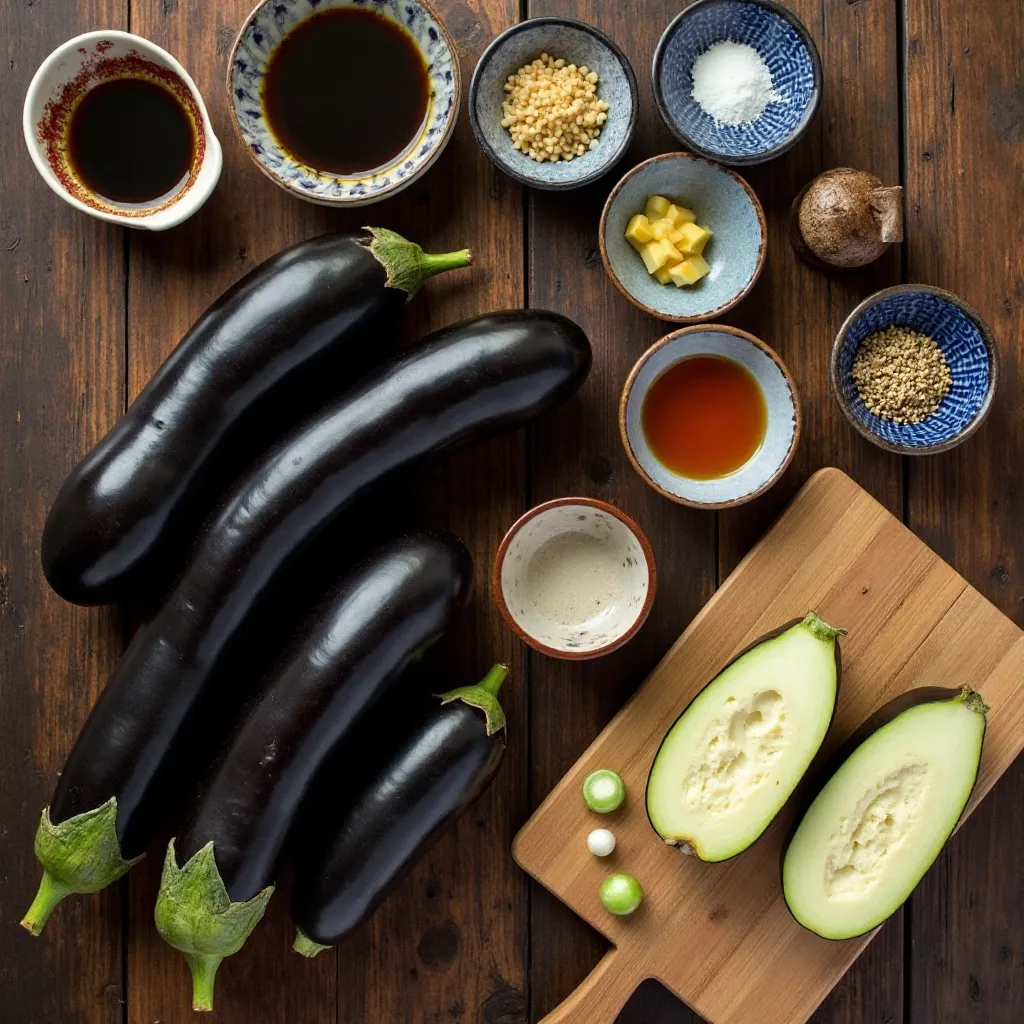
Step-by-Step Instructions
Step 1: Prepare Your Eggplants
Rinse the Japanese eggplants under cold water and pat them completely dry with a kitchen towel. This is important—excess moisture will prevent them from getting crispy! Cut off the stem ends, then slice each eggplant in half lengthwise. If your eggplants are particularly thick (more than 1.5 inches in diameter), you might want to cut them into quarters lengthwise instead.
Using a sharp knife, score the flesh side in a crosshatch pattern, making diagonal cuts about 1/4 inch deep. Don’t cut through to the skin! These cuts help the seasonings penetrate and allow the eggplant to cook more evenly. I learned this trick from my Japanese neighbor, and it’s been a game-changer.
Step 2: Season the Eggplant
Place the eggplant halves in a large bowl. Drizzle with your chosen oil, making sure to get some on the scored flesh. Use your hands to massage the oil into those cuts—this ensures every bite is flavorful. Sprinkle with salt, pepper, and garlic powder. Toss gently to coat all sides evenly.
Here’s a pro tip: let the seasoned eggplant sit for 5-10 minutes if you have time. This allows the salt to draw out some moisture, which leads to even better caramelization. You’ll notice tiny beads of moisture forming on the surface—that’s exactly what you want!
Step 3: Arrange in the Air Fryer
Preheat your air fryer to 375°F (190°C) for about 3 minutes. This step isn’t absolutely necessary, but I find it helps with even cooking. Arrange the eggplant halves in a single layer in your air fryer basket, flesh side up. Make sure they’re not overlapping—air circulation is key to getting that crispy exterior.
If your air fryer is on the smaller side, you may need to cook in batches. Don’t be tempted to crowd them! I made that mistake once and ended up with steamed rather than roasted eggplant. Not the vibe we’re going for!
Step 4: Air Fry to Golden Perfection
Cook the eggplant for 12-15 minutes, depending on their size and your air fryer model. At the 7-minute mark, carefully flip them over using tongs or a spatula. This ensures both sides get beautifully golden.
You’ll know they’re done when the flesh is deeply golden brown with some darker caramelized spots, and a fork slides through easily. The skin should be wrinkled and the inside completely tender. If they need more time, add 2-3 minutes and check again.
Step 5: Apply the Glaze (Optional but Incredible)
While the eggplant is cooking, whisk together all your glaze ingredients in a small bowl. Once the eggplant is done, remove it from the air fryer and brush the glaze generously over the flesh side while it’s still hot. The heat will help the glaze absorb into those beautiful crosshatch cuts.
If you want an extra layer of flavor, you can return the glazed eggplant to the air fryer for 1-2 minutes to caramelize the sauce slightly. Watch it closely though—the sugars in the glaze can burn quickly!
Step 6: Garnish and Serve
Transfer your gorgeous air fryer Japanese eggplant to a serving platter. Sprinkle with toasted sesame seeds, sliced green onions, and any other garnishes you love. I sometimes add a squeeze of fresh lime juice for brightness. Serve immediately while it’s hot and at its most delicious!
What to Serve Air Fryer Japanese Eggplant With
This versatile dish plays well with so many foods! Here are my favorite pairings:
As a Side Dish:
- Serve alongside teriyaki chicken or salmon for a complete Japanese-inspired meal
- Pair with steamed jasmine rice and miso soup for a comforting dinner
- Add to a Buddha bowl with quinoa, edamame, and pickled vegetables
- Serve with grilled steak
As a Main Course:
- Top with a fried egg and serve over rice for a satisfying vegetarian meal
- Stuff into warm pita bread with tahini sauce and fresh herbs
- Chop and toss with soba noodles, vegetables, and sesame dressing
- Layer over crispy rice cakes with avocado and spicy mayo
Perfect Beverage Pairings:
- Iced green tea or barley tea
- Sparkling water with fresh cucumber and mint
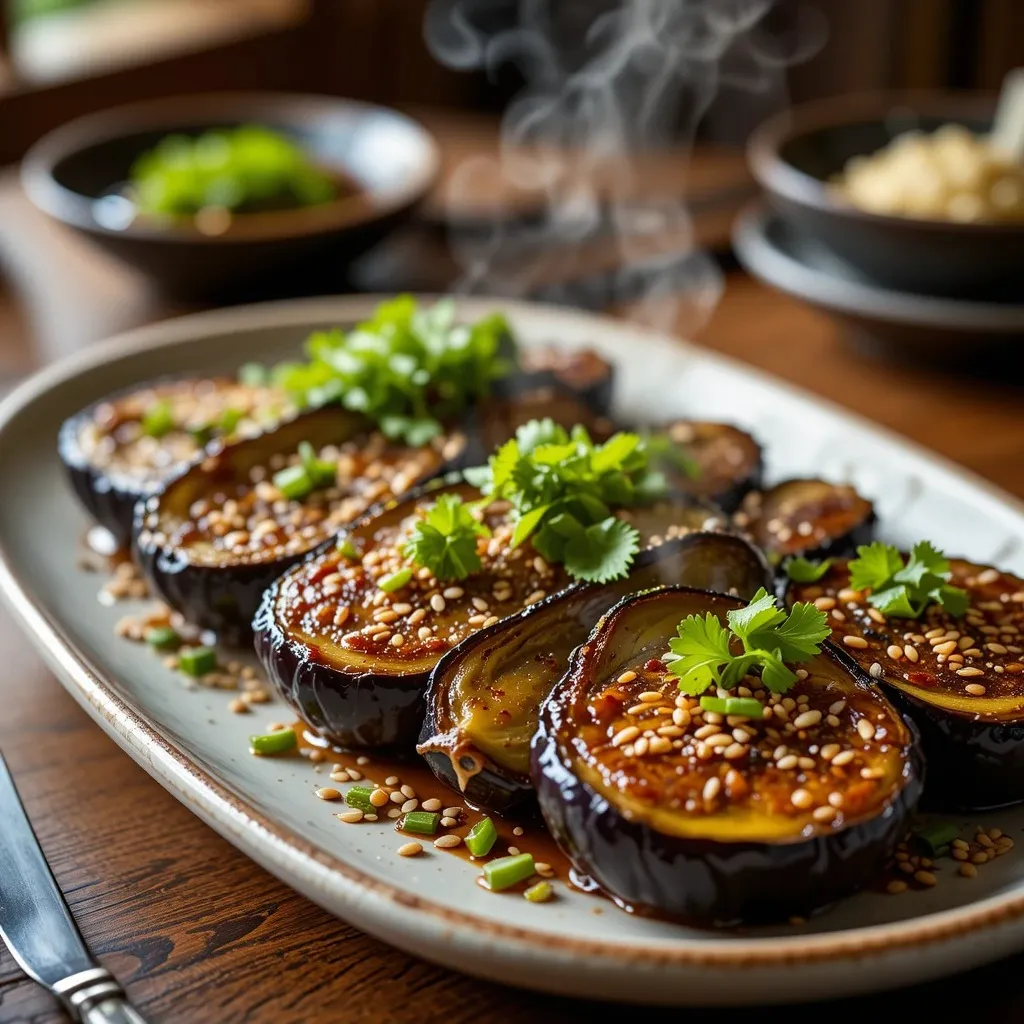
Top Tips for Perfecting Air Fryer Japanese Eggplant
Choose the Right Eggplants
Japanese eggplants should feel firm and heavy for their size with glossy, unblemished skin. Avoid any with soft spots or wrinkled skin—these are past their prime. Smaller, younger eggplants tend to be sweeter with fewer seeds, so grab those if you can find them.
Don’t Skip the Scoring
Those crosshatch cuts aren’t just for looks! They help the eggplant cook faster and more evenly while allowing seasonings and glazes to penetrate deep into the flesh. Make your cuts about 1/4 inch apart and 1/4 inch deep for best results.
Oil is Your Friend (But Not Too Much)
You need enough oil to promote browning, but not so much that the eggplant becomes greasy. One to two tablespoons for 2-3 eggplants is the sweet spot. If you’re watching oil intake, use a spray bottle to apply a light, even coating.
Temperature Matters
I’ve tested this recipe at various temperatures, and 375°F is the magic number. Lower temperatures steam the eggplant rather than roasting it, while higher temps can burn the outside before the inside is tender. Trust the process!
Watch Out for Overcrowding
This is the most common mistake I see. Eggplant pieces need space around them for hot air to circulate. If they’re touching or overlapping, you’ll get steamed, mushy eggplant instead of crispy, caramelized perfection. Cook in batches if needed!
Flip for Even Cooking
Flipping halfway through ensures both the flesh and skin sides get proper exposure to the heat. Set a timer so you don’t forget—it makes a real difference in the final texture.
Adjust Cooking Time Based on Size
Thinner eggplants might only need 10-12 minutes, while thicker ones could take up to 18 minutes. Start checking at 12 minutes and add time as needed. Every air fryer runs a little differently too, so get to know yours!
Experiment with Seasonings
While the Asian-inspired flavors are traditional, don’t be afraid to get creative. Try Italian herbs with parmesan, Middle Eastern spices with tahini, or Mexican seasonings with lime and cilantro. Japanese eggplant is like a blank canvas!
Storing and Reheating Tips
Refrigerator Storage:
Let the eggplant cool completely before storing. Place in an airtight container with a paper towel on the bottom to absorb excess moisture. Properly stored, air fryer Japanese eggplant will keep in the refrigerator for 3-4 days.
I’ll be honest—leftover eggplant won’t be quite as crispy as fresh, but it’s still delicious! The flavors actually deepen overnight as the seasonings have more time to penetrate.
Reheating Instructions:
The air fryer is your best bet for reheating. Preheat to 350°F and cook for 4-5 minutes until heated through and the exterior crisps up again. You can also use a toaster oven set to 350°F for similar results.
Avoid the microwave if possible—it makes the eggplant soggy and ruins that beautiful texture we worked so hard to achieve. If you must microwave, use 50% power in short 30-second bursts.
Freezing (Not Recommended):
I’m going to level with you—eggplant doesn’t freeze particularly well due to its high water content. When thawed, it becomes mushy and loses that delightful texture. If you must freeze it, do so only if you plan to use it in a cooked dish like curry or pasta sauce where texture is less important.
Meal Prep Tip:
You can prep the eggplant (wash, cut, score, and season) up to 24 hours in advance. Store the prepped eggplant in an airtight container in the fridge, then cook when ready. This makes weeknight dinners so much easier!
Frequently Asked Questions
Do I need to salt and drain Japanese eggplant before cooking?
Unlike large globe eggplants, Japanese eggplants typically don’t require salting and draining because they contain fewer seeds and less moisture. They’re naturally sweeter with less bitterness. However, if you want to be extra cautious, you can lightly salt them and let sit for 10 minutes, then pat dry.
Can I use regular eggplant instead of Japanese eggplant?
Absolutely! Globe eggplant works too, but you’ll need to adjust the cooking method slightly. Cut it into 1-inch thick rounds or planks, salt and drain for 20-30 minutes to remove bitterness, then pat very dry before air frying. Cooking time may increase to 18-20 minutes.
Why is my eggplant not getting crispy?
The most common culprits are: too much moisture (make sure to dry thoroughly), not enough oil, overcrowding the basket, or cooking at too low a temperature. Also, ensure your eggplant is fresh—old eggplant contains more moisture and won’t crisp up as well.
Is the skin edible?
Yes! Japanese eggplant skin is thinner and more tender than regular eggplant, making it perfectly edible and actually quite delicious when roasted. It adds nice texture and contains beneficial nutrients, so don’t peel it off.
Can I make this recipe oil-free?
While a small amount of oil helps with browning and prevents sticking, you can make this with minimal or no oil. Use a light spray of cooking spray or vegetable broth instead. The result won’t be quite as caramelized, but it’ll still be tasty!
What’s the best way to cut Japanese eggplant?
For air frying, I recommend cutting them in half lengthwise and scoring the flesh in a crosshatch pattern. This maximizes surface area for browning and allows seasonings to penetrate. For very thick eggplants, quarter them lengthwise instead.
How do I know when it’s done cooking?
The eggplant should be deeply golden brown with caramelized spots, the flesh should feel very soft when poked with a fork, and the skin should be wrinkled. If you insert a knife or fork, it should slide through with zero resistance.
Can I add cheese to this recipe?
Definitely! Try sprinkling mozzarella, parmesan, or feta over the eggplant during the last 2-3 minutes of cooking. The cheese will melt beautifully. This works especially well with Italian-style seasonings instead of Asian flavors.
Tips for Avoiding Common Mistakes
Mistake #1: Not Drying the Eggplant Properly
Excess moisture is the enemy of crispiness. After washing, use a clean kitchen towel or paper towels to thoroughly dry each piece. Even better, let them air dry for 10 minutes after patting them down. Water on the surface will steam the eggplant instead of roasting it.
Mistake #2: Using Old or Overripe Eggplant
Fresh eggplant has firm flesh and glossy skin. Overripe eggplant is spongy, contains more seeds, and has a bitter flavor that no amount of seasoning can fix. Press gently on the eggplant—if it leaves an indent, it’s too old. Choose ones that bounce back.
Mistake #3: Cutting Pieces Too Thick
If your eggplant halves are more than 1.5 inches at their thickest point, the outside will burn before the inside cooks through. Cut thicker eggplants into quarters lengthwise, or slice into rounds instead of keeping them whole.
Mistake #4: Skipping the Preheat
While not absolutely essential, preheating your air fryer for 3-5 minutes helps jump-start the browning process and leads to more even cooking. It’s like preheating your oven—worth the extra few minutes!
Mistake #5: Opening the Air Fryer Too Often
I know it’s tempting to check constantly, but every time you open the basket, you release heat and disrupt air circulation. Check once at the halfway point to flip, then resist until the timer goes off. Trust the process!
Mistake #6: Not Adjusting for Your Specific Air Fryer
All air fryers are different! Some run hotter, some have more powerful fans, and basket sizes vary. The first time you make this recipe, start checking a minute or two before my suggested time, and make notes about what works for your specific model.
Nutrition Information
| Nutrient | Per Serving (1/4 recipe) |
|---|---|
| Calories | 95 |
| Total Fat | 4g |
| Saturated Fat | 0.5g |
| Sodium | 350mg |
| Total Carbohydrates | 14g |
| Dietary Fiber | 5g |
| Sugars | 8g |
| Protein | 2g |
| Vitamin C | 6% DV |
| Potassium | 10% DV |
Note: Nutrition information is an estimate and will vary based on specific ingredients used, especially if you add the optional glaze.
There you have it—everything you need to make incredible air fryer Japanese eggplant! This recipe has become a weekly staple in my kitchen, and I have a feeling it’ll become one in yours too. The combination of crispy edges and creamy centers is simply irresistible.
What I love most about this dish is how adaptable it is. Some nights I keep it simple with just salt and pepper, other times I go all out with the miso glaze and fancy garnishes. Both versions are equally delicious!
Have you tried making Japanese eggplant in your air fryer? I’d love to hear how it turned out for you! Drop a comment below and let me know what seasonings you used or what you served it with. And if you snap a photo, tag me on Instagram—I love seeing your creations!

